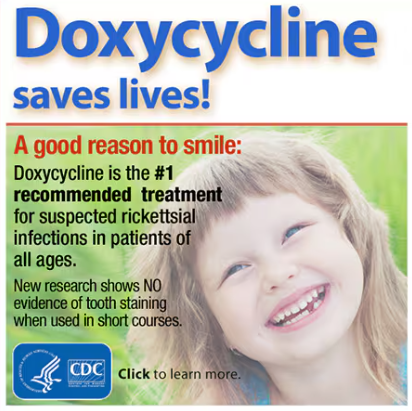Spotted fever group rickettsioses (spotted fevers) are a group of diseases caused by closely related bacteria. These bacteria are spread to people through the bite of infected mites and ticks. Rocky Mountain Spotted Fever (RMSF) is the most serious and commonly reported disease in the spotted fever family. The causative agent of the disease, Rickettsia rickettsii, is transmitted in Indiana by the bite of an infected American dog tick (Dermacentor variabilis). RMSF is the most severe disease of the group and can be deadly if not treated early, especially in children.
Rickettsia parkeri rickettsiosis, causative agent Rickettsia parkeri, is another disease in the spotted fever family. Rickettsia parkeri has been found in Gulf Coast ticks (Amblyomma maculatum) collected mostly in southern Indiana counties.
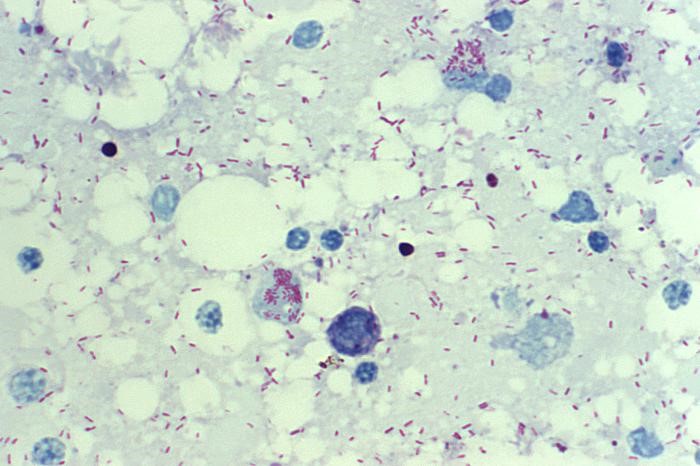
Rocky Mountain spotted fever bacteria (Rickettsia rickettsii) inside cells. Photo: Centers for Disease Control and Prevention.
- Transmission
Rickettsia rickettsii is transmitted in Indiana by the American dog tick (Dermacentor variabilis).
Rickettsia parkeri has been found in Gulf Coast ticks (Amblyomma maculatum) collected in southern Indiana counties.
- Signs and Symptoms
Rocky Mountain Spotted Fever (RMSF)
Signs and symptoms of RMSF usually appear within 3–12 days of a bite from an infected tick. Untreated RMSF can rapidly progress to a serious and life-threatening illness.
People in the early stages of illness can experience flu-like symptoms, such as:
- High fever
- Severe headache
- Malaise
- Myalgia
- Edema around eyes and on the back of hands
- Gastrointestinal symptoms (nausea, vomiting, anorexia)
Rash is a common sign in people who are sick with RMSF. Rash usually develops 2-4 days after fever begins. The look of the rash can vary widely over the course of illness. Some rashes can look like red splotches and some look like pinpoint dots. While almost all patients with RMSF will develop a rash, it often does not appear early in illness, which can make RMSF difficult to diagnose.
Late stage signs and symptoms (5 days and beyond) include:
- Altered mental status, coma, cerebral edema
- Respiratory compromise (pulmonary edema, ARDS)
- Necrosis, requiring amputation
- Multiorgan system damage (CNS, renal failure)
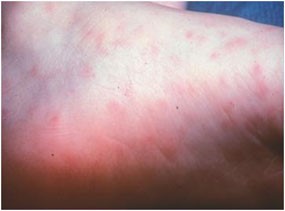
Early-stage rash in an RMSF patient. Photo: Centers for Disease Control and Prevention.
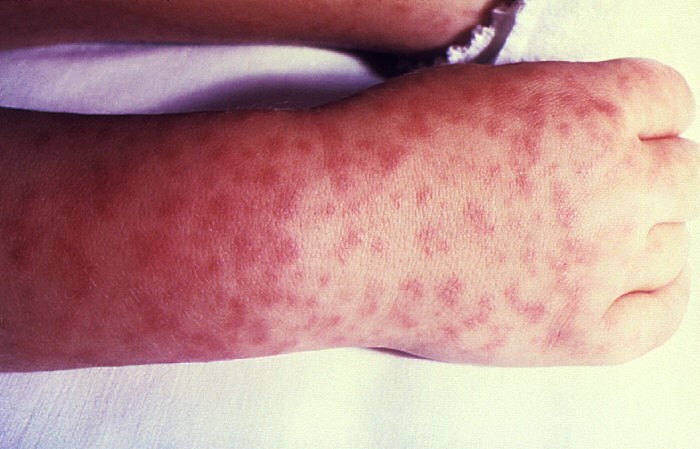
Late-stage rash in an RMSF patient. Photo: Centers for Disease Control and Prevention.
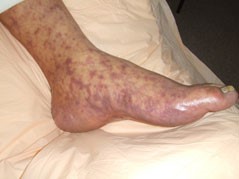
Advanced late-stage rash in an RMSF patient. Photo: Centers for Disease Control and Prevention.
Rickettsia parkeri Rickettsiosis
Signs and symptoms of R. parkeri rickettsiosis usually appear within 2–10 days of a bite from an infected tick. R. parkeri rickettsiosis is characteristically less severe than RMSF and almost always associated with an inoculation eschar (ulcerated, necrotic lesion) at the site of tick attachment. Several days after an eschar appears, the following can develop:
- Fever
- Headache
- Rash (sparse maculopapular or papulovesicular eruptions on the trunk and extremities)
- Muscle aches
R. parkeri rickettsiosis can be difficult to distinguish from RMSF, especially during early stages of these diseases. However, eschars are uncommonly identified in persons with RMSF.
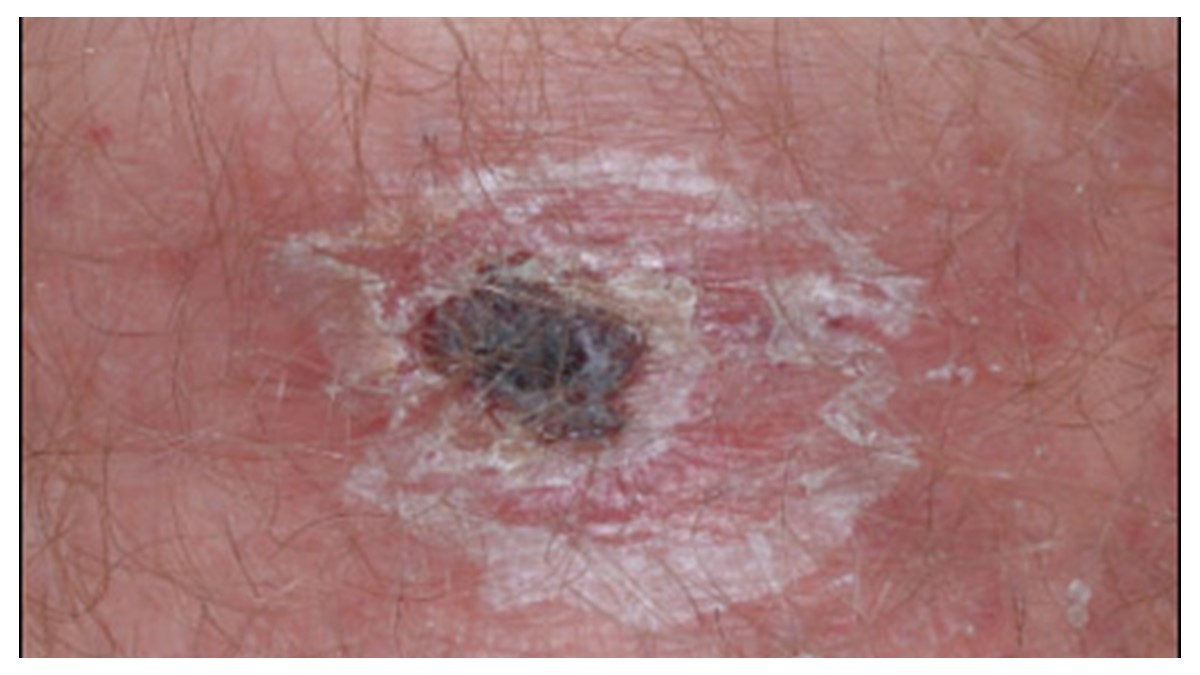
Eschar at the site of a mite or tick bite on a patient with R. parkeri rickettsiosis. Photo: Centers for Disease Control and Prevention.
- Diagnosis
Diagnosis of RMSF or other spotted fevers is based upon the patient’s signs and symptoms, a history of possible exposure to ticks, and appropriate laboratory testing. Early recognition of symptoms is important for prompt diagnosis and treatment. If you think that you have RMSF, contact your health care provider right away.
People who have removed an attached tick sometimes wonder if they should have it tested for tick-borne diseases. Although some laboratories offer this testing, IDOH does not recommend it. If the tick tests positive, it does not necessarily mean that you have been infected; if the tick tests negative, it may provide a false sense of security because you may have been unknowingly bitten by a different tick that was infected.
- Treatment
Doxycycline is the treatment of choice for adults and children of all ages with suspected spotted fever infections. Doxycycline is most effective at preventing severe complications and death if it is started within the first five days of symptoms. Treatment should be started for anyone with suspected spotted fever infections and should never be delayed while waiting for laboratory test results.
Doxycycline is the recommended antibiotic treatment for RMSF. Graphic: Centers for Disease Control and Prevention.
- Prevention
The best way to prevent any tick-borne disease is to avoid tick bites. Please see our tick prevention page for more information.
For more information about RMSF and other spotted fevers, please visit the CDC's website.
- Maps and Statistics
For RMSF and R. parkeri rickettsiosis data and statistics in Indiana, please visit the Indiana Tick-borne Disease Surveillance Dashboard.
National statistics for RMSF can be found at the CDC RMSF Epidemiology and Statistics webpage .
- Resources
Information for Providers
For RMSF diagnosis, treatment, and testing information from CDC click here.
Page last reviewed/updated: January 2025

